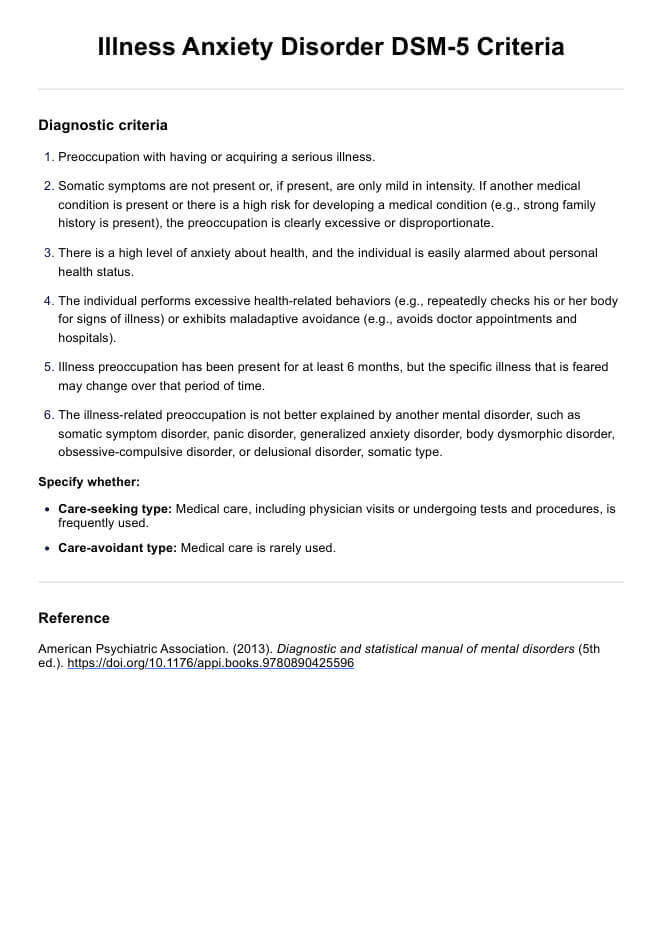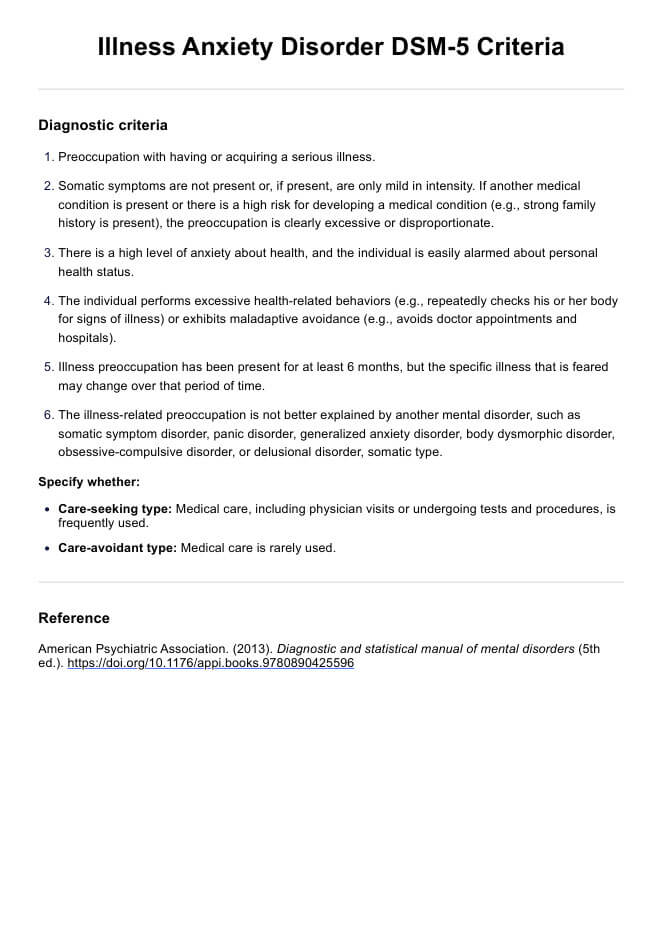Illness Anxiety Disorder DSM-5 Criteria
Learn about the DSM-5 criteria for diagnosing Illness Anxiety Disorder and see an example of its symptoms.


What is illness anxiety disorder?
Formerly called hypochondriasis, illness anxiety disorder is a mental condition marked by a fixation on developing a serious medical condition. People who have this underlying mental condition frequently believe that typical bodily symptoms indicate a serious underlying medical condition, which causes them much misery and disability.
The primary focus of people with an illness anxiety disorder is on the worry and dread of disease rather than the actual somatic symptoms, in contrast to people with somatic symptom disorders, who predominantly feel physical symptoms. Illness anxiety disorder is classified under somatic symptom and related disorders under the Diagnostic and Statistical Manual of Mental Disorders (DSM-5).
Many times, this illness is mistaken for other mental health illnesses, such as panic disorder, which is marked by frequent panic episodes, or body dysmorphic disorder, which causes people to obsess over perceived physical flaws. However, the enduring worry that one is suffering from a serious disease, even in the absence of supporting medical assessments, is the defining feature of this severe health anxiety disorder.
Illness Anxiety Disorder DSM-5 Criteria Template
Illness Anxiety Disorder DSM-5 Criteria Sample
How is illness anxiety disorder diagnosed?
The DSM-5, published by the American Psychiatric Association, provides criteria for diagnosing illness anxiety disorder. This diagnosis covers those concerned about developing a dangerous, undiagnosed medical illness. In contrast to those with somatic symptom disorder, who mostly exhibit physical symptoms, people with illness anxiety disorder have little to no somatic symptoms.
Usually, a normal physical examination cannot find any major medical problem that may account for the patient's worries. The person's perception of benign symptoms or typical physiological sensations, such as temporary tinnitus or orthostatic dizziness, is the source of the worry. Despite negative diagnostic results and assurances from doctors, this results in clinically significant distress about health and illness.
Individuals with illness anxiety disorder often engage in excessive health-related behaviors, such as repeatedly checking their body for signs of illness or researching their symptoms online. Their health concerns dominate their daily lives, affecting their activities and relationships.
This persistent health anxiety, despite the absence of significant somatic symptoms, differentiates illness anxiety disorder from other mental health disorders such as generalized anxiety disorder and panic disorder.
Illness anxiety disorder DSM-5 diagnosis criteria
According to the DSM-5, illness anxiety disorder is diagnosed based on specific criteria (American Psychiatric Association, 2013a):
- Preoccupation with having or acquiring a serious illness.
- Somatic symptoms are not present or, if present, are only mild in intensity. If another medical condition is present or there is a high risk factors of developing a medical condition (e.g., a strong family history is present), the preoccupation is clearly excessive or disproportionate.
- There is a high level of anxiety about health, and the individual is easily alarmed about personal health status.
- The individual performs excessive health-related behaviors (e.g., repeatedly checks his or her body for signs of illness) or exhibits maladaptive avoidance (e.g., avoids doctor appointments and hospitals).
- Illness preoccupation has been present for at least 6 months, but the specific illness that is feared may change over that period of time.
- Other mental disorders, such as somatic symptom disorder, panic disorder, generalized anxiety disorder, body dysmorphic disorder, obsessive-compulsive disorder, or delusional disorder somatic type do not better explain the illness-related preoccupation.
Specify whether:
- Care-seeking type: Medical care, including visiting primary care physicians or undergoing tests and procedures, is frequently used.
- Care-avoidant type: Medical care is rarely used.
Differences between the DSM-IV and DSM-5 criteria
The transition from DSM-IV to DSM-5 brought significant changes to the conceptualization and diagnosis of what was previously known as hypochondriasis. In DSM-5, this condition has been replaced by two new diagnoses: illness anxiety disorder and somatic symptom disorder. This change reflects a more nuanced understanding of health-related anxiety and its manifestations.
Moreover, the DSM-IV criteria for hypochondriasis emphasized the misinterpretation of bodily symptoms. In contrast, DSM-5 criteria for illness anxiety disorder focus on excessive anxiety about having or acquiring a serious illness, which may occur with or without somatic symptoms (American Psychiatric Association, 2013b.)
How is illness anxiety disorder treated and managed?
Treating and managing this high-health anxiety condition involves a combination of therapeutic approaches and, in some cases, medication. The primary goal is to reduce health-related anxiety and improve the quality of life for patients. Below are key treatment and management strategies for illness anxiety disorder patients.
Cognitive behavioral therapy (CBT)
Cognitive behavioral therapy (CBT) is the most effective treatment for illness anxiety disorder. Mindfulness-based cognitive therapy helps patients understand the connection between their thoughts, feelings, and behaviors related to health anxiety. CBT also incorporates stress management techniques and behavioral strategies to help patients manage their anxiety.
Health preoccupation diagnostic interview
The Health Preoccupation Diagnostic Interview is valuable in assessing and diagnosing illness anxiety disorder. This structured interview helps clinicians evaluate the extent of a patient's health-related anxiety and differentiate it from other somatic symptoms and related disorders.
Medication
In some cases, medication may be prescribed to help manage medically unexplained symptoms of illness anxiety disorder. Selective serotonin reuptake inhibitors (SSRIs), commonly used to treat major depressive disorder and other anxiety disorders, can be effective in reducing health-related anxiety.
Psychoeducation
Educating patients about their condition is crucial in managing illness anxiety disorder. Psychoeducation involves teaching patients about the nature of their medical disorder, the role of cognitive and behavioral factors in maintaining their symptoms, and the rationale behind their treatment plan. This knowledge empowers patients to take an active role in their treatment and reduces their anxiety by demystifying their symptoms.
Regular follow-up and support
Ongoing support and regular follow-up appointments with healthcare providers are essential for managing illness anxiety disorder. These follow-ups help monitor the patient's progress, address any concerns, and make necessary adjustments to the treatment plan. Continuous support reassures patients and helps prevent relapse.
Commonly asked questions
Illness anxiety disorder in the DSM-5 is characterized by a preoccupation with having or acquiring a serious illness, accompanied by high levels of anxiety about health. Individuals often misinterpret normal bodily sensations as signs of severe illness.
Illness anxiety disorder focuses on the fear of having a serious illness despite mild somatic symptoms or no somatic symptoms. In contrast, Somatic Symptom Disorder involves distressing physical and severe symptoms that may or may not be associated with a diagnosed medical illness.
Criteria for illness anxiety disorder include preoccupation with health, minimal somatic symptoms, excessive health-related behaviors or avoidance, and the preoccupation lasting at least six months without explanation by another mental disorder that is causing excessive concern.





















-template.jpg)


















































































